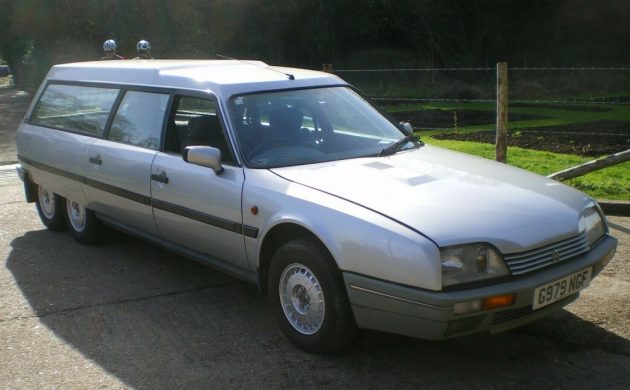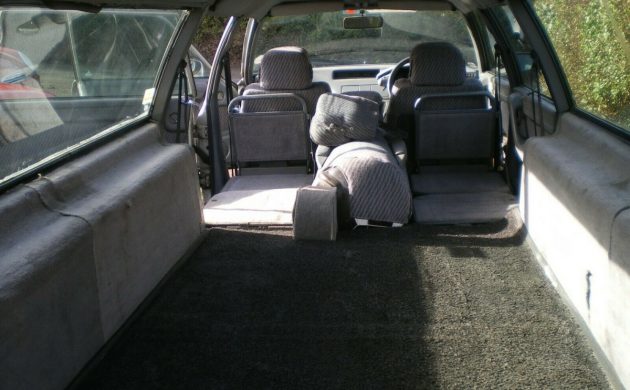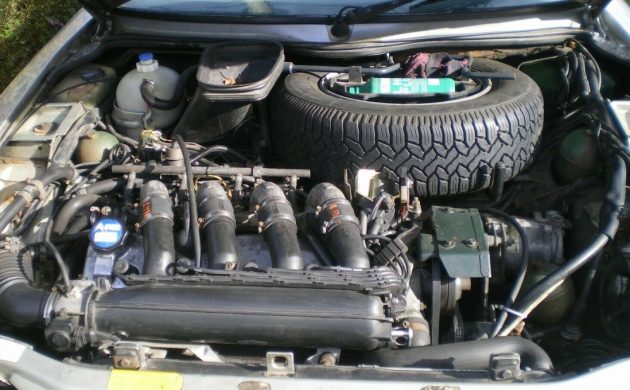The Citroen CX Break (wagon) was introduced in 1975 as a replacement for the ID/DS Break. With its long wheelbase and spacious cargo area, it was intended to go tête à tête with the Peugeot 504 (later 505) Break models which were some of the biggest passenger cars available in Europe at the time. Aside from the unique hydropneumatic suspension, the main difference that set the CX apart from its conventional Peugeot rivals was its front-wheel-drive layout. This drivetrain packaging allowed the body to be stretched and chopped into various commercial versions without having to worry about lengthening the driveshaft. These variants included ambulances, flatbeds, and this six-wheeled wagon available here on eBay with bidding to GBP 6,966.00 ($9,627.01) and the reserve not yet met.
The seller of this stretched six-wheel CX says that these long wagons, known as Loadrunners, were built in the 1980s in France, Belgium, and Germany for high-speed overnight transport of newspapers to be delivered in the morning. Unlike the newspaper cars, this one spent the first fifteen years of its life as a four-wheeled version, the owner having it converted to a Loadrunner by a CX specialist in Germany in 2004. He states that with the rear seats folded down it will easily fit a 4×8 sheet of plywood and that he has even carried twelve-foot timbers. Between the rear seats, there is a tank for an aftermarket liquid petroleum gas (LPG) conversion which somewhat reduces the loading space.
This example is a right-hand-drive UK-market model with a four-speed automatic transmission. There are 219,000 miles on the odometer, but a replacement engine was installed in 2012 which the owner assumes has now covered around 125,000 miles. The alloy wheels were refinished in 2019 and fitted with new Michelin tires. The hydropneumatic and cooling systems are in good condition, though some electrical and braking issues must be sorted before the car can be driven. The body was repainted in 2017 but the seller indicates that there are some outstanding rust issues. A potential buyer would want to pay special attention to the seams where the body was lengthened. The owner states that the conversion used less body filler than the earlier versions and that the box sections were rustproofed while the body was cut apart. The interior received a new dashboard and the lengthened headliner is in good condition. The seats, door cards, and carpeting are all a bit tired, but most of these could probably be sourced from a standard CX wagon.
Given that only a few hundred Loadrunners were made and most were used as work vehicles, it can be assumed that they are rare nowadays. Although rarity does not always equal increased value, this one is creeping up to almost $10,000 with eight bidders and more than a week left to go. Despite being eligible for import to the United States, it’s not clear if the owner will sell this car outside of the UK, so a bidder would want to clarify that first. No matter where in the world you are located, you’d likely never see another six-wheeled CX. What would you haul in yours?





I also thought Michelin tire also used the loadrunner for full load tire test and development.
Citroën developed a different rig for Michelin tire-testing. It’s not the Loadrunner. It is a 10-wheeler, having 4 steering wheels. 11 tires are touching the ground when testing, used most for big tires. Look here to see the coverage of this machine:
https://www.thedrive.com/news/37188/michelin-built-this-freakish-10-wheeled-citroen-to-test-truck-tires-at-110-mph
Johnathan, Loadrunner? Roadrunner? Make up your mind… I would just rather have a Peugeot 505 wagon.
If I had to guess that is a copy-editing mistake and not the author’s.
Low Runner
I think you’re right!
A 4 by 8 sheet of plywood! Count me in. I would love to have a wagon that had that much utility. I think trucks are cool and may even get another one someday, but I prefer to be down low when driving, so a wagon such as this one would be superb. Not too keen on the idea of driving on the right side, though, in a left driving country.
Most so called “trucks” today can’t hold a 4×8 sheet of plywood anyway. I’ll hang on to my 2000 F-350 with an 8′ bed.
The one I had was pink. Have to admit that this car had the most amazing suspension of any car I’ve ever ridden in and I’ve ridden and drove thousands of cars. Handled speed bumps like they weren’t even there.
https://barnfinds.com/pretty-in-pink-1987-citroen-cx-wagon/
I just see a hearse!
An insane attention getter. Funny that it has all that crazy cargo space and yet they still have to jam the full size spare in the engine compartment.
It’s not jammed. It’s all engineered to fit. The engine and transmission unit is small by US standards.
Would make a cool hearse.
That LPG tank in the passenger compartment seems like a disaster waiting to happen. I read a safety bulletin at work once about a work crew that had a torch in the back of a pickup with a cap on. A leak overnight in an enclosed space. When the crew opened the door in the morning the dome light somehow arced and boom!
PLEASE NO TIMEWASTERS!!, ok i am out.
Great post.
Strange car. Hey, why not put three axles under the rear? Or, better yet, why not just make it a “half-track?” I’m kinda wondering why they were not put into production? Can you imagine a Pinto or a Gremlin sporting rubber treads?? Meanwhile, the Yolo County Classic car show and swap yesterday was fabulous!
they made half tracks almost 100 years ago
Would this be a ” dually ” ?
Is it April 1 all over again?
Looks like something out of a bad 1970s sci-fi movie.
With much respect I wish the owner luck and much more luck with the new owner.
A Frenchman chain smoking in a car with an LP tank inside. What could go wrong!
All lines to and from the tank are sealed and vented to the outside so no fumes or gas can get inside the vehicle.
Here’s one real potential problem with this car:
See that black PLASTIC intake manifold hanging over the exhaust header??
Yes, it is right over the header with no heat shield! Back around 1986 or so I was at our Natl. Citroen rendezvous at Northfield mountain, Mass. It’s always held on Father’s Day, mid June, and that Suday, last day of meet, it was HOT. As a Michigan fellow was starting his CX to drive back to Detroit, 750 miles away, the engine started to fade, then died. He opened the hood and found the air runners from the plastic plenum had been sucked FLAT due to the buildup of underhood heat from the exh manifold! The airflow was shut down as that plastic used for this part was polypropylene, cheap stuff, which has too low a melting point for use over the exhaust! – Major kerfluffle! Mounting a plastic intake over the exhaust manifold itself was a horrendous booboo, but using too cheap a plastic compounded the problem! If they had used a nylon similar to the Citroen DS21 engine fan (first plastic fan in the world), the part would not have melted.
When I saw this, I knew instantly what the problem was, yet crazily enough, I had the perfect solution for it – I had the only replacement part for this in the whole US, back in my file cabinet in Detroit! I had been given a complete manifold by a Citroen engineer I met in Paris during a biztrip, and we had talked plastics in cars.
Back to the intake manifold: Members at the meet did a temporary fix on the intake by cutting 4 broomstick pieces & shoving them into the intake runners like inside splints to keep them from collapsing flat & shutting off all air to the cylinders. That worked well enough for the owner to drive to Boston to stay with friends overnight. But he still faced the 750 mile trek to Detroit. I called my office Mon. morning & asked them to Fedex the part overnight to his Boston address. They did, he installed it, and made the trip back to Detroit ok as the car was moving fast enough to keep the new manifold from melting! Later Citroen returned this part to aluminum, at higher cost and weight. Would have been ok if made of high temp nylon with glass fiber reinforcement, which is what Detroit finally started to do, after learning that Europe mfrs were 20 yrs ahead of Detroit. In 1995 I worked with Ford’s Engine Engineering group to put the first all plastic intake on the 4.6L Ford engine, and later was instrumental in developing their vibration-welded intake for the 6 cyl 3L Ford Vulcan engine, using the larges vibration welding machine in the US at that time which I had had installed in our Troy Mich. development facility.
Famille Un Camionster